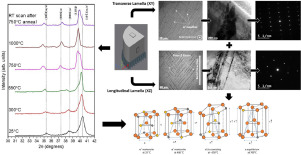当前位置:
X-MOL 学术
›
Acta Mater.
›
论文详情
Our official English website, www.x-mol.net, welcomes your feedback! (Note: you will need to create a separate account there.)
Mechanism of Stress Relaxation and Phase Transformation in Additively Manufactured Ti-6Al-4V via in situ High Temperature XRD and TEM Analyses
Acta Materialia ( IF 9.4 ) Pub Date : 2020-04-01 , DOI: 10.1016/j.actamat.2020.02.056 F.R. Kaschel , R.K. Vijayaraghavan , A. Shmeliov , E.K. McCarthy , M. Canavan , P.J. McNally , D.P. Dowling , V. Nicolosi , M. Celikin
Acta Materialia ( IF 9.4 ) Pub Date : 2020-04-01 , DOI: 10.1016/j.actamat.2020.02.056 F.R. Kaschel , R.K. Vijayaraghavan , A. Shmeliov , E.K. McCarthy , M. Canavan , P.J. McNally , D.P. Dowling , V. Nicolosi , M. Celikin

|
Abstract Additive manufacturing is being increasingly used in the fabrication of Ti-6Al-4V parts to combine excellent mechanical properties and biocompatibility with high precision. Unfortunately, due to the build-up of thermal residual stresses and the formation of martensitic structure across a wide range of typical processing conditions, it is generally necessary to use a post-thermal treatment to achieve superior mechanical performance. This investigation aims to obtain a deeper understanding of the micro/nanostructural evolution (α′ martensite phase decomposition), accounting for the kinetics of phase transformation during the heat treatment of 3D-printed Ti-6Al-4V alloy. As the mechanism of phase transformation and stress relaxation is still ambiguous, in this study the changes in crystal lattice, phase, composition and lattice strain were investigated up to 1000°C using both in situ high temperature X-ray diffraction (XRD) and transmission electron microscopy (TEM). Based on the result a mechanism of phase transformation is proposed, via the accommodation/substitution of Al, V and Ti atoms in the crystal lattice. The proposed mechanism is supported based on elemental concentration changes during heat treatment, in combination with changes in crystal structure observed using the high temperature XRD and TEM measurements. This study provides a deeper understanding on the mechanism of phase transformation through martensitic decomposition, as well as a deeper understanding of the influence of post-thermal treatment conditions on the alloy's crystal structure.
中文翻译:

通过原位高温 XRD 和 TEM 分析增材制造 Ti-6Al-4V 中应力松弛和相变的机制
摘要 增材制造越来越多地用于制造 Ti-6Al-4V 零件,以将优异的机械性能和生物相容性与高精度相结合。不幸的是,由于热残余应力的积累和马氏体结构在各种典型加工条件下的形成,通常需要使用后热处理来实现卓越的机械性能。本研究旨在深入了解微/纳米结构演变(α'马氏体相分解),解释 3D 打印 Ti-6Al-4V 合金热处理过程中的相变动力学。由于相变和应力松弛的机制尚不明确,本研究对晶格、相、使用原位高温 X 射线衍射 (XRD) 和透射电子显微镜 (TEM) 研究了高达 1000°C 的组成和晶格应变。基于该结果,提出了一种相变机制,通过晶格中的 Al、V 和 Ti 原子的容纳/取代。基于热处理过程中元素浓度的变化,结合使用高温 XRD 和 TEM 测量观察到的晶体结构变化,支持了所提出的机制。这项研究提供了对马氏体分解相变机制的更深入理解,以及对后热处理条件对合金晶体结构的影响的更深入理解。
更新日期:2020-04-01
中文翻译:

通过原位高温 XRD 和 TEM 分析增材制造 Ti-6Al-4V 中应力松弛和相变的机制
摘要 增材制造越来越多地用于制造 Ti-6Al-4V 零件,以将优异的机械性能和生物相容性与高精度相结合。不幸的是,由于热残余应力的积累和马氏体结构在各种典型加工条件下的形成,通常需要使用后热处理来实现卓越的机械性能。本研究旨在深入了解微/纳米结构演变(α'马氏体相分解),解释 3D 打印 Ti-6Al-4V 合金热处理过程中的相变动力学。由于相变和应力松弛的机制尚不明确,本研究对晶格、相、使用原位高温 X 射线衍射 (XRD) 和透射电子显微镜 (TEM) 研究了高达 1000°C 的组成和晶格应变。基于该结果,提出了一种相变机制,通过晶格中的 Al、V 和 Ti 原子的容纳/取代。基于热处理过程中元素浓度的变化,结合使用高温 XRD 和 TEM 测量观察到的晶体结构变化,支持了所提出的机制。这项研究提供了对马氏体分解相变机制的更深入理解,以及对后热处理条件对合金晶体结构的影响的更深入理解。



























 京公网安备 11010802027423号
京公网安备 11010802027423号